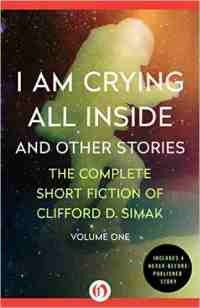
Published by Open Road Media on October 20, 2015
Collecting stories that span four decades, this volume offers a worthy introduction to Clifford Simak’s short fiction. The stories are representative of the subjects that animated much of Simak’s fiction during his long career, including robots, mutants, and time travel. The real treat for Simak fans, however, is the previously unpublished “I Had No Head and My Eyes Were Floating Way Up in the Air,” a story that Simak wrote for inclusion in Harlan Ellison’s never-to-be-published The Last Dangerous Visions. Of course, the story’s title makes a playful allusion to Ellison’s own work. The story is about a prideful man who discovers and lays claim to a planet, only to be remade in the image of … something other than a man. Simak’s dark take on what it means to be human is one of the volume’s highlights.
Robots are the central characters in “I Am Crying All Inside,” which draws a distinction between folk (who drink moonshine and stand in the shade when it’s hot) and people (who don’t). Those with wealth and power have gone into space, leaving behind the obsolete folk and people. The story plays with the theme of human dependence on robots which, in science fiction, always leads to a bad end. (Personally, sitting around and drinking moonshine while robots do all the work seems like a pretty good life to me.) If it had included dogs, the story could easily have been wedged into City, the novel that Simak formed from a series of related stories.
Intergalactic traders (a mixture of humans and robots) plan to cash in on a contract for tubers from which an important drug can be extracted, but the natives on the planet where the tubers are grow have become unexpectedly reluctant to part with their crops. Could the drunken alien they found picnicking on the planet have something to do with their reticence? In the tradition of science fiction tales that extoll the virtues of competition, “Installment Plan” suggests that the competitive nature of humans will always give them an edge, even when their alien competitors cheat.
Robots also appear in “Ogre” (in the form of an annoyingly meticulous bookkeeper), but the story is about alien plant life and the addictive music made by trees. Like “Installment Plan,” “Ogre” involves greedy humans underestimating insidious aliens.
“All the Traps of Earth” is about a robot who has been in operation for longer than the law allows (another subject Simak wove into the City stories). It addresses several of Simak’s favorite themes: the right to be yourself, to define your own identity (albeit in the context of a robot); the nature of justice; whether a robot can have a soul; and the benefits of living a simple, useful life, meeting the needs of others while satisfying the need for companionship. Like many robot stories, “All the Traps of Earth” can easily be understood as a metaphor for intolerance of anyone who is different from the norm. But the story also involves evolution, another of Simak’s recurring topics, this time in the form of evolving robots. It is my favorite story in the volume.
“Small Deer” is a time travel story that explains the extinction of the dinosaur -- a fate that might soon be visited upon smaller inhabitants of Earth. A longer time travel story, “Gleaners,” provides a lighthearted view of the bureaucratic turmoil involved in visiting the past.
“Madness from Mars,” a story about the discovery of intelligent life on Mars, is more dated and less successful than the other stories, but it remains an interesting take on the choices (and excuses) humans will make to cover up a disaster.
“The Call from Beyond” mixes science fiction (primarily space travel and gene manipulation) with horror. A mutant flees to Pluto to escape persecution and discovers that Earth is not the only dangerous place to live. The story echoes some of the themes Simak explored in Ring Around the Sun.
For a change of pace and a seemingly odd choice for the volume, “Gunsmoke Interlude” is a western, one of many (according to the editorial notes) that Simak wrote during the middle years of the twentieth century. A good story is a good story, regardless of genre, and this one, about a gunslinger who makes a hard decision, is one of the better stories in the anthology.
RECOMMENDED